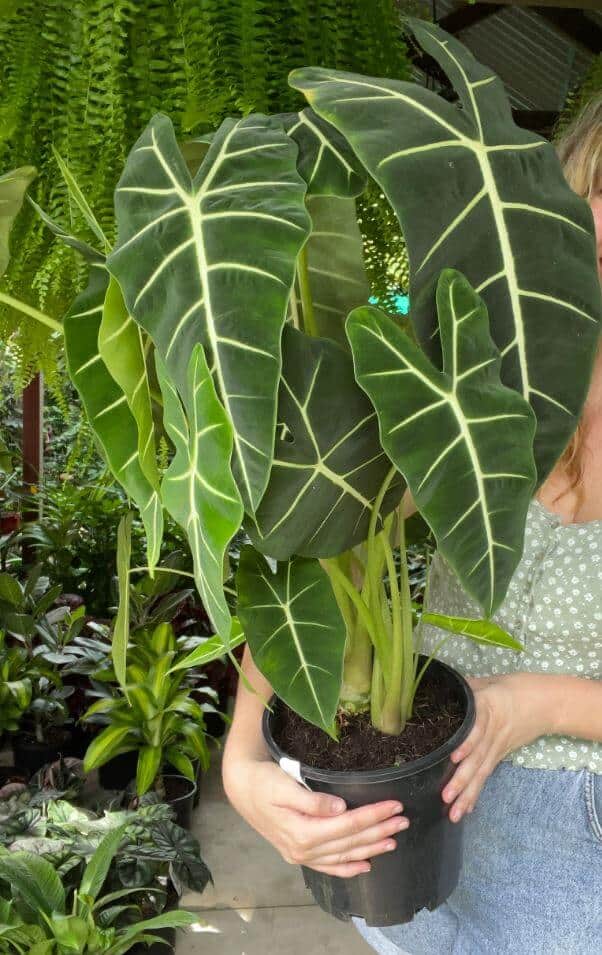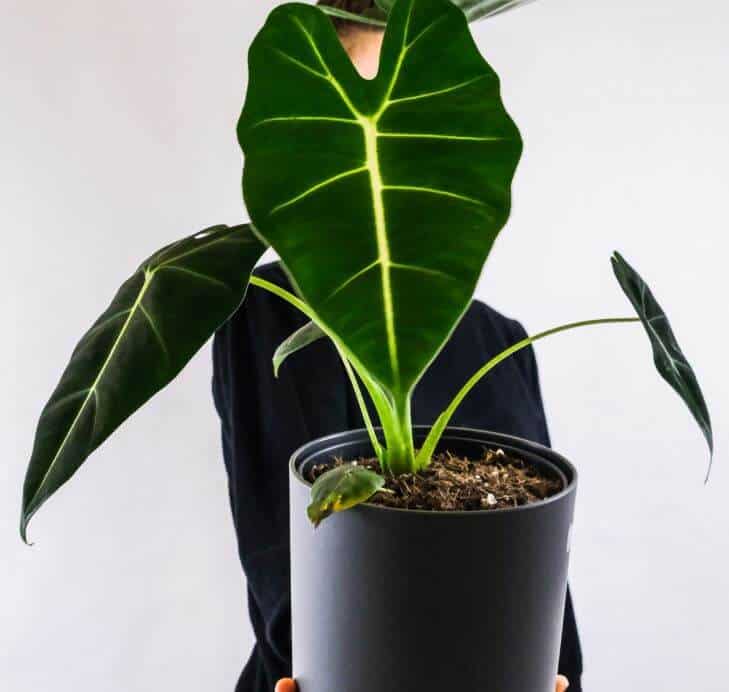Last Updated on September 3, 2023 by a Friendly Gardener
If you love green, luxurious, and alocasia species, the Alocasia Green Velvet is a must for your indoor plant collection. Botanically identified as the Alocasia Micholitziana ‘Frydek’, is strikingly beautiful thanks to its magnificent foliage. Its popularity has increased significantly in recent years. Alocasia varieties can be challenging but are certainly worth the effort.
A native of the Philippines, this tropical jewel appreciates indirect light, regular watering, and a little TLC to keep it looking its best. Flowers are unimpressive and have the form of a light green spathe with a cream-colored spadix, however, plants cultivated indoors rarely bloom.
Alocasia Green Velvet Plant Care

Basic care for the Alocasia Green Velvet plant is relatively straightforward, but a bit of extra attention should be dedicated to the watering habit.
Soil

Ideally, the soil must be well-draining. Blend a mix of peat, perlite, and organic compost. Peat should account for approximately 60%, while 30% should be perlite. The remaining 10% should be organic compost for nutrition. Peat can be substituted with coconut coir.
Light
The green velvet alocasia thrives when provided with ample bright but indirect light. This is a plant that demonstrates sensitivity to light levels and can suffer if it receives too much or too little. Find a location such as near a window where there is natural bright light where shadows are cast. It should not be exposed to direct sunlight.
Even an hour of direct sunlight can cause leaves to scorch or cause tips and edges to turn brown and crispy. It is the beauty of the foliage that makes this plant so desirable, so direct sunlight is not recommended.
If the plant receives too little light, the plant’s growth rate will slow considerably. Lower foliage may begin to yellow giving the plant a sickly look. Low light conditions also contribute to problems connected to overwatering because the soil bed takes longer to dry out.
Water
Alocasia varieties are challenging when it comes to a watering schedule. Thick stems store water as do petioles, so they share some water storage abilities with succulents. They do not, however, tolerate drought, yet they are susceptible to overwatering. Work to keep the soil bed evenly moist. Do not allow it to dry out or to become soggy. You can opt to soak your plant and then drain it when the top two inches dry out. Make sure the container offers adequate drainage and is not overly large as more soil retains more water.
Do not plan on using a specific watering schedule but watch your Alocasia green Velvet for signs that it needs watering. During winter dormancy water requirements lessen. Water sparingly with small amounts to avoid overwatering.
Humidity
These tropical beauties do best in locations featuring 50% or higher humidity levels. Low humidity can cause leaf edges and tips to brown. If your indoor humidity is lower, create a pebble humidity tray and place it beneath the plant’s container or use a small space humidifier to rectify the conditions.
Temperature
The Green Velvet plant is a tropical native that grows beneath other vegetation. Indoor temperatures should measure between 65° and 85°F. Do not expose your plant to temps that fall below 60°F. as this can send your plant into dormancy or cause it to die back.
Keep this plant away from drafts regardless of whether hot or cold. They should never be placed near air conditioning or heating vents or units.
Feeding

The Alocasia green velvet likes to feed. Use a liquid houseplant fertilizer with an NPK of 20-20-20 monthly during the growing season. Dilute it to half-strength to avoid burning the roots. You can also opt for compost or worm castings if you prefer an organic choice.
Pruning
The green Velvet Alocasia does not require much pruning. When lower foliage turns brown and shrivels, it should be removed.
Repotting a Green Velvet Plant

The Green Velvet plant does best in a small pot. Do not repot into a larger container until there is evidence that your plant is root bound. When roots peek from drainage openings or the soil, it’s time to repot. Soil that dries out very quickly is also indicative of a need to repot.
When repotting, select a new container that is no more than one inch larger. Water your plant the day before repotting to reduce stress. After you have repotted, water lightly.
Alocasia Green Velvet Plant Propagation

The easiest method for alocasia propagation is through division. During the growing season, in spring and summer, remove your plant and dived the root system into two or more sections. Only propagate using larger alocasia plants. The root system growing habit is clumping with rhizomes. Rhizomes produce new stem growth which can be separated from the parent plant. Rhizomes can be cut with a sterilized garden knife. Place separate plant sections in moistened soil in a spot with moderate light to reduce stress on the new plants.
Alocasia Green Velvet Problems
Diseases associated with the Green Velvet plant are generally instigated by overwatering. These include root rot, crown rot, and bacterial leaf spot. If you select the correct pot size, well-draining soil, and are careful when watering, these infections can be prevented. In the case of root and crown rot, infected parts of the plant should be removed, and the remaining healthy sections replanted in a fresh dry soil mix. With bacterial leaf spot disease, infected leaves should be removed to prevent spreading.
The most common pests to attack alocasia species are sap-sucking bugs. Aphids, spider mites, scale, mealybugs, and thrips appear to favor these plants. Examine your plant closely and weekly for evidence of pest infestations. Check both the tops and undersides of foliage for signs which might include webbing, white cottony deposits, or brown waxy deposits. If you suspect a pest infestation, spray your plant with a water jet spray and then treat the Green Velvet plant with an insecticidal soap solution or with a horticultural oil such as neem oil.
Alocasia Green Velvet Toxicity
The Green Velvet plant contains calcium oxalate crystals which are irritating if chewed or ingested. Keep the Alocasia Frydek away from children and pets. If you suspect ingestion contact medical or veterinary professionals.
These crystals irritate the digestive tract and mouth. Watch for difficulty breathing, drooling, or vomiting. Other symptoms can include difficulty swallowing, foaming, or pawing at the mouth, irritation of the mouth, lips, tongue, or eyes, a loss of appetite, diarrhea, and tremors.

